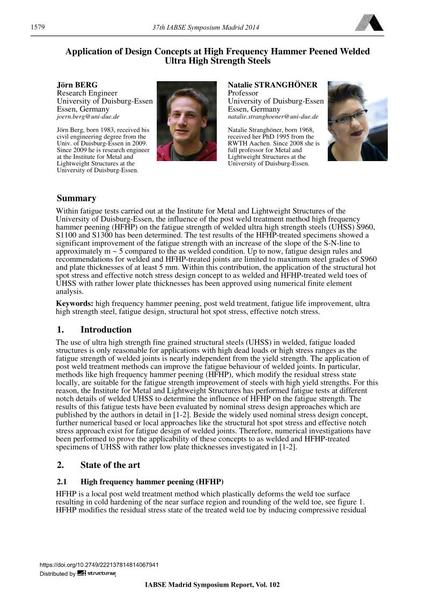Application of Design Concepts at High Frequency Hammer Peened Welded Ultra High Strength Steels

|
|
|||||||||||
Bibliografische Angaben
| Autor(en): |
Jörn Berg
Natalie Stranghöner |
||||
|---|---|---|---|---|---|
| Medium: | Tagungsbeitrag | ||||
| Sprache(n): | Englisch | ||||
| Tagung: | IABSE Symposium: Engineering for Progress, Nature and People, Madrid, Spain, 3-5 September 2014 | ||||
| Veröffentlicht in: | IABSE Symposium Madrid 2014 | ||||
|
|||||
| Seite(n): | 1579-1586 | ||||
| Anzahl der Seiten (im PDF): | 8 | ||||
| Jahr: | 2014 | ||||
| DOI: | 10.2749/222137814814067941 | ||||
| Abstrakt: |
Within fatigue tests carried out at the Institute for Metal and Lightweight Structures of the University of Duisburg-Essen, the influence of the post weld treatment method high frequency hammer peening (HFHP) on the fatigue strength of welded ultra high strength steels (UHSS) S960, S1100 and S1300 has been determined. The test results of the HFHP-treated specimens showed a significant improvement of the fatigue strength with an increase of the slope of the S-N-line to approximately m ~ 5 compared to the as welded condition. Up to now, fatigue design rules and recommendations for welded and HFHP-treated joints are limited to maximum steel grades of S960 and plate thicknesses of at least 5 mm. Within this contribution, the application of the structural hot spot stress and effective notch stress design concept to as welded and HFHP-treated weld toes of UHSS with rather lower plate thicknesses has been approved using numerical finite element analysis. |
||||
| Stichwörter: |
Ermüdungsbemessung
|
||||
